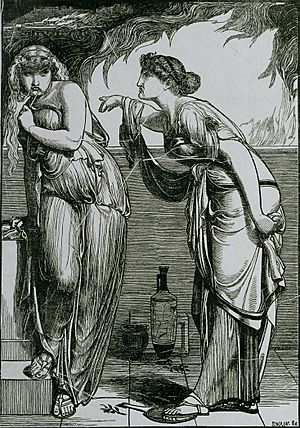Cassandra facts for kids
Cassandra, also known as Alexandra or Kassandra, was a princess of Troy. Her parents were King Priam and Queen Hecuba. She is famous for her special gift: she could see the future! But there was a sad twist: no one ever believed her prophecies. This is why her name is now used to describe someone whose warnings are ignored.
One common story says that the god Apollo gave Cassandra the power to see the future. However, when she refused his love, he cursed her. He spat into her mouth, making sure that even though she could see the future, no one would ever believe her predictions. Another story says she gained her gift when snakes licked her ears while she slept in a temple, allowing her to understand the future.
Cassandra became an important figure in ancient Greek stories and plays.
Cassandra's Warnings About Troy

Cassandra saw the terrible future for her city, Troy. She tried to warn the Trojans about the Trojan Horse, telling them that Greek soldiers were hidden inside. She also predicted the death of Agamemnon, her own death, and the sad fate of her mother, Hecuba. Cassandra even foresaw that her cousin Aeneas would escape Troy's fall and create a new nation in Rome.
Sadly, no one listened to her. Because of Apollo's curse, she could not stop these tragedies from happening.
Cassandra was the first to see the body of her brother Hector when it was brought back to Troy.
In the story The Fall of Troy, Cassandra tried to warn her people again about the Trojan Horse. The Trojans were celebrating their victory, thinking the Greeks had left. Cassandra knew better. She grabbed an axe and a burning torch and ran towards the giant wooden horse, wanting to destroy it herself. But the Trojan people stopped her, thinking she was crazy. The Greeks hidden inside the horse were surprised by how much Cassandra knew about their secret plan.
When Troy finally fell, Cassandra sought safety in the temple of Athena. She held onto a wooden statue of Athena for protection. However, Ajax the Lesser dragged her away, even knocking over the statue. This act was considered a serious offense against the gods, especially because Cassandra was seeking protection in a sacred place.
Cassandra's Death
After the fall of Troy, Cassandra was taken by Agamemnon, the king of Mycenae, as a captive. She was brought to his home. There, she was killed by Agamemnon's wife, Clytemnestra, and her lover, Aegisthus. Cassandra had foreseen her own death but, as always, could not prevent it.
It is believed that Cassandra was buried in Mycenae. The archaeologist Heinrich Schliemann thought he found her tomb when he excavated Mycenae, discovering the remains of a woman and two infants in one of the ancient graves.
After her death, Cassandra's soul was said to have gone to the Elysian Fields, a paradise in the Greek underworld, because she had been devoted to the gods during her life.
Images for kids
-
Cassandra puts herself under the protection of Pallas, a statue by Aimé Millet (1819-1891) in the Tuileries Garden, Paris.
See also
 In Spanish: Casandra para niños
In Spanish: Casandra para niños



